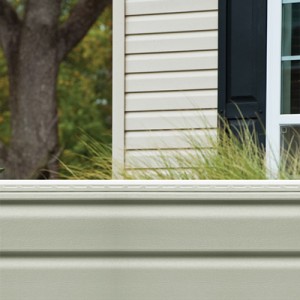Siding allows you to add definition and color to your home. Nowadays, there are numerous options to help you create your desired look, and a great deal of consideration goes in to making an informed choice.

“While aesthetics are important, you will also want to consider durability, maintenance, and energy efficiency,” said Christopher Wittmann, CR, a NARI Certified Remodeler, Senior Sales Representative, and Exterior Product Specialist with Callen. “From a functional standpoint, siding offers protection. From an architectural standpoint, it is common to utilize an array of materials to highlight particular features on a home.” Keeping this in mind, Christopher provides an overview of the six most popular types of siding available today.
“Insulated and non-insulated vinyl siding has become the most popular choice for homeowners in the United States,” said Christopher. Available in horizontal, vertical, and shake-styles, vinyl can either retain certain architectural elements of a house or dramatically change the overall appearance. “Although the ‘plastic look’ of certain vinyl siding products deters some design professionals and homeowners, the wide selection of colors and styles and its low investment price explains the siding’s status. If energy efficiency is desired as part of the upgrade, insulated vinyl siding reduces ‘thermal bridging’ where energies can transfer through the siding and framing materials, reducing the thermal insulation properties of the building.”
Fiber-cement siding offers the natural look of wood, stucco, or shake. In addition, it’s fairly low-maintenance, non-flammable, termite and woodpecker-resistant, and typically lasts at least 25 years or more. “Available in a range of styles and textures, factory painting or finishes are highly recommended,” he said. “Since fiber-cement siding can experience moisture-related issues if not installed properly, special care is needed for certain areas on the house to ensure the materials remain sustainable.”
Engineered, composite wood siding has gained popularity through the years. Like fiber-cement, this product also shares some of the same characteristics. One of the benefits of composite wood siding is that it is more impact resistant than fiber cement and vinyl. It’s also light-weight and easy to install, which can lower labor costs.
“While more costly than vinyl or composite siding products both initially and long-term, wood siding offers a rich look and is quite durable when maintained properly,” said Christopher. When contemplating this option, note that it does require regular maintenance (painting or staining to prevent weather damage) and can be susceptible to insect and rodent attacks. Depending on maintenance, wood siding has a varying life expectancy, lasting anywhere from 10 to sometimes 100 years. “Wood siding comes in clapboard as well as shakes and shingles. Western red cedar and redwood are known for being attractive and durable and are considered the best choices if real wood is desired,” added Wittmann.
The final option is brick, stone, and stone-veneer siding. “Homeowners who prefer siding that adds texture and visual interest to their home are drawn to the natural beauty and durability of brick or stone,” said Christopher. Because brick or stone requires certain installation requirements and is more labor intensive, cost concerns should be taken into account. Brick or stone-veneer siding is more lightweight and less expensive than natural brick and stone and is available in both natural and synthetic materials. There are several styles available to help enhance a home’s curb appeal. If properly maintained, these options can last a home’s lifetime.
In terms of siding color, “Changing the color not only has the ability to affect how a person views their home, but it can impact the home’s value as well,” he said. If unsure about what siding colors to choose, Wittmann suggests contemplating the following questions to help in the decision making process:
- 1. What is the neighborhood like? Although you may want to put your stamp on your own unique siding color scheme, you also want to consider your home’s location when making a selection.
- 2. What is the home’s architecture style? The type of home can offer visual cues, but don’t feel restricted to these when it comes to siding color selection. “For example, although Colonial homes are notably painted in a single color (usually white), unusual accents can offer a subtle, yet modern twist to a classic scheme. If you live in a cottage or country style home, you may have more freedoms when it comes to siding color,” said Wittmann.
- 3. How big is the house? A dark color may look diverse and rich, but when painted on the exterior of a mid- to large-scale home, it could seem gloomy and overbearing. On the opposite spectrum, colors that are too light may cause a smaller home to blend in to its surrounding landscape, preventing it from standing out. “Keep this in mind: lighter colors neutralize features that you wish to de-emphasize, while darker colors draw attention to places you want to highlight,” said Wittmann.
- 4. What color is the roof? Although siding colors have a varying lifespan, a roof will probably last from 20 to 30 years. As a result, roof color should be an element considered when choosing siding colors. “If your roofing material is dark, you may want to utilize a lighter color scheme for your siding,” Wittmann said. “If you have a more neutral roof hue, this may give you a broader selection of color schemes from which to choose.”
- 5. What landscaping style is in place or is planned? A contemporary landscape combined with a candy-colored exterior color scheme may not be the most complementary choice, especially in a conservative neighborhood. It’s just one instance of how landscape plays an important role when determining siding colors.
- 6. What is the climate? The look of a particular siding color can change based on the weather. For instance, a siding color may look different on a sunny day than it does on a snowy afternoon. It’s considered a rule of thumb that the intense sunlight during the summertime makes colors feel brighter.
- 7. How do favorite paint colors look at different times of the day? Apply sample swatches of the desired siding colors on different sides of the home and look at them closely in the morning, afternoon, and evening. Be sure to paint the swatches close to items on your home that won’t change color, such as brick foundations.
- 8. Have you considered complementary colors? One siding color does not constitute a color scheme. A main hue requires lighter or darker accents. Choose two or three shades to update window trim, doors, and railings. “If you’re unsure, pick one complementary color that offers a bright focal point and one hue that’s a shade or two lighter or darker than your main siding color,” said Wittmann.
“Once you understand all the siding materials and color options and you’ve weighed the pros and cons of each, you are sure to make an informed decision that you can be confident in and proud of,” said Christopher.
For more information or to arrange an initial Design Center consultation, call Callen at 414-529-5509.



Leave a Reply